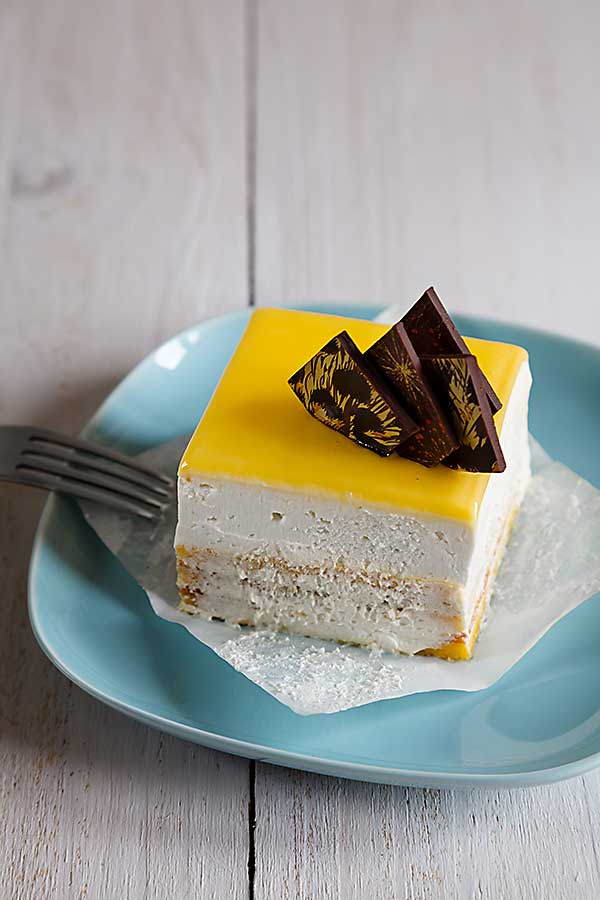Bavarois
Bavarois, otherwise known as bavarian cream or creme bavaroise, is a type of sweet, velvety custard dessert. The base for bavarois is crème anglaise, which is thickened by adding egg yolks, sugar, vanilla, and cream or milk. The dessert is carefully cooked in a water bath before mixing in gelatine or isinglass to further thicken the mixture. Whipped cream is then folded in to add a special lightness to the dish.
The dessert is then left to set in a cold mould, and then unmoulded before serving on the plate. True bavarois is set in a fluted mould and chilled until it achieves a firm texture. The mould can first be coated with a fruit gelatine to produce a glazed effect on the final product. Bavarois is best served with fruit sauce, apricot or raspberry puree, or to fill charlottes. It can also be used as a filling for doughnuts instead of pastry cream.
How do you thicken bavarian cream?
Special attention must be paid when thickening a bavarois. To achieve the perfect texture, the dish should be heated to 80°C and constantly stirred while inside the water bath. To check if the right density has been achieved, you should be able to form waves on the surface of the cream when blowing on it. When the cream reaches the desired texture, gelatine can be dissolved before adding the whipped cream. This is another tricky part of perfecting bavarois, as whipped cream needs to be folded in at the exact right temperature. If the cream is too warm, the whipped cream will immediately liquify. If the cream is not warm enough, then the dish will set too fast and lose its desired texture.
What’s the difference between bavarois and mousse?
Mousse and bavarois are very similar in texture and appearances, however there are differences in the way the terms are used. Both mousse and bavarois are made from a flavour base, enricher, lightener, and stabiliser, which is what makes them share similar characteristics. The difference between mousse and bavarois, however, is that the term mousse is much more flexible and versatile than bavarois. Mousse can be used as a filling or as a dessert of its own. It can be made in various flavours and served as either a sweet or savoury dish (e.g. you could make an asparagus mousse if you so desired). Mousse can also be served in various ways: either in a mould or free-form, spread out on a dish or used in a filling or stuffing.
On the other hand, bavarois is always sweet and always served in a mould, never free-form. It is a very specific term that refers to a particular recipe and use of ingredients. Here are some ways that bavarois differs from mousse:
- Flavours: Bavarois always uses crème Anglaise as its flavour base (milk, eggs yolks, sugar). Mousse can be flavoured with virtually anything, from chocolate to cauliflower to bacon.
- Enrichment: Both bavarois and mousse are similar in that they can use additional light flavourings such as vanilla, fruit, or spices. No differences here!
- Lightener: When it comes to lightening, bavarois is always lightened with whipped cream. Mousse, on the other hand, can be lightened with anything from meringue or the use of an immersion blender.
- Stabiliser: Bavarois is always stabilised with gelatin, while mousse can used any type of stabiliser.
Basically, the difference between mousse and bavarois is that mousse is more versatile and flexible while bavarois has very specific ingredients and recipe.
Who created bavarois?
French chef and exponent of grande cuisine, Marie-Antoine Carême, is sometimes credited with inventing bavarian cream. The dish first started appearing in cookbooks in the late 1800s, in the Boston Cooking School cookbooks.
Private Chefs, Art of Dining
CHEFIN is a private chef platform that’s reimagining social dining.
You can easily connect with 1 of our 250 private chefs and treat your guests to restaurant-quality dining experiences in the comfort of your own home, office or chosen venue. From high-end dining to quirky social food experiences, the CHEFIN platform makes it effortless for you to access gourmet food that’s worthy of a Michelin-starred establishment.
What you get:
-
- Your very own private chef who is vetted and insured,
- A customised menu for your needs,
- 24/7 concierge support,
- Complete post-dinner cleanup,
- A fun, stress-free, and unforgettably dining experience!


